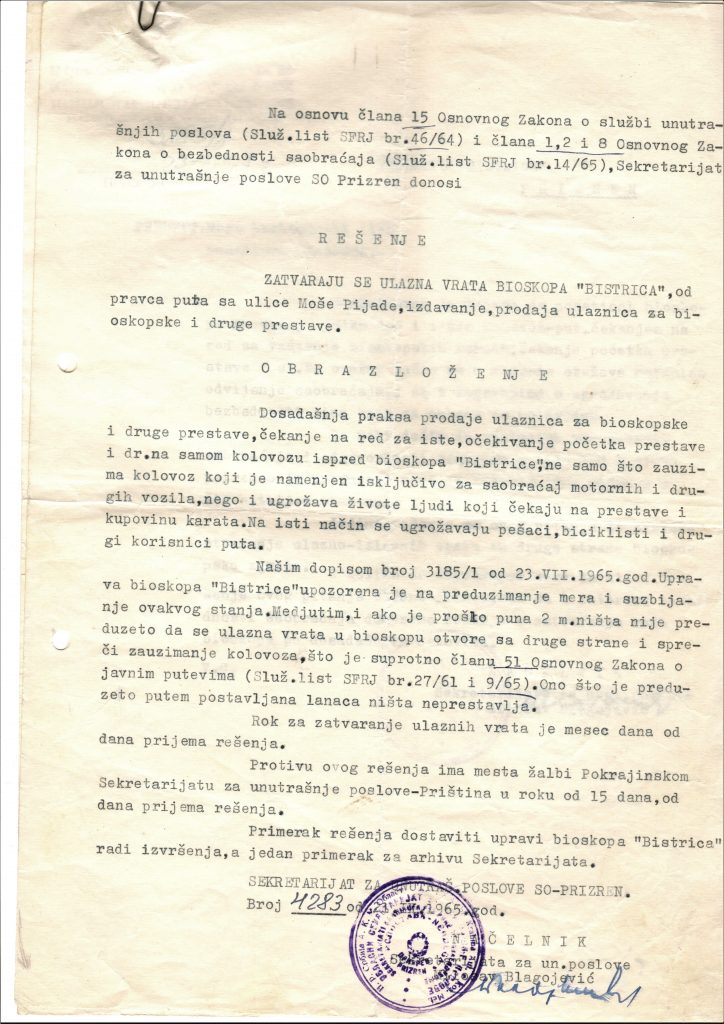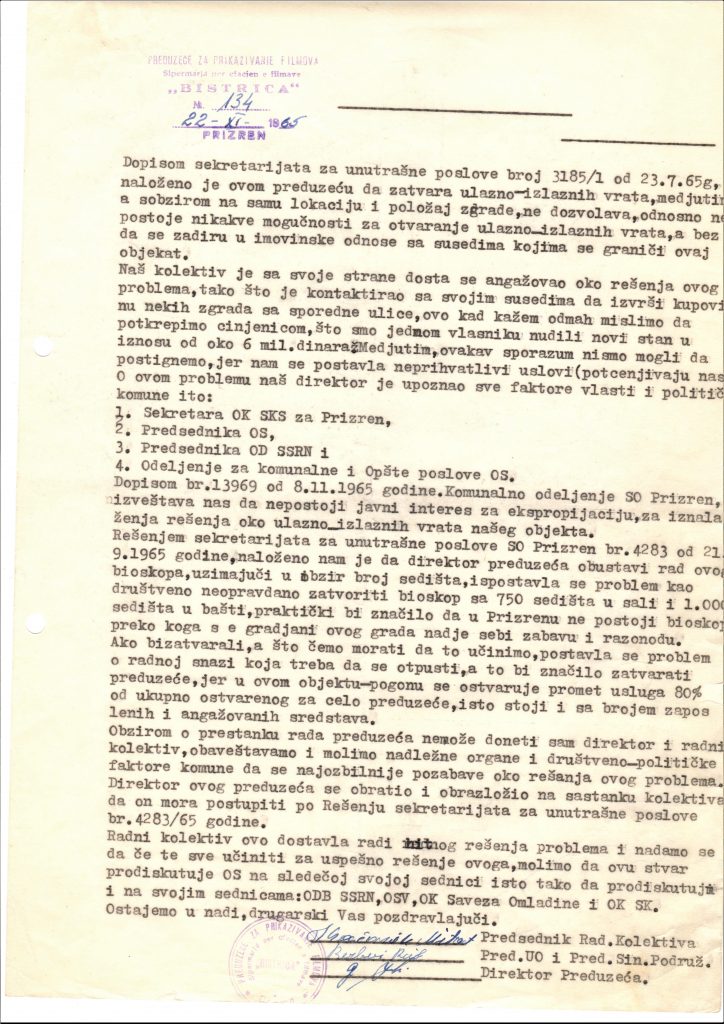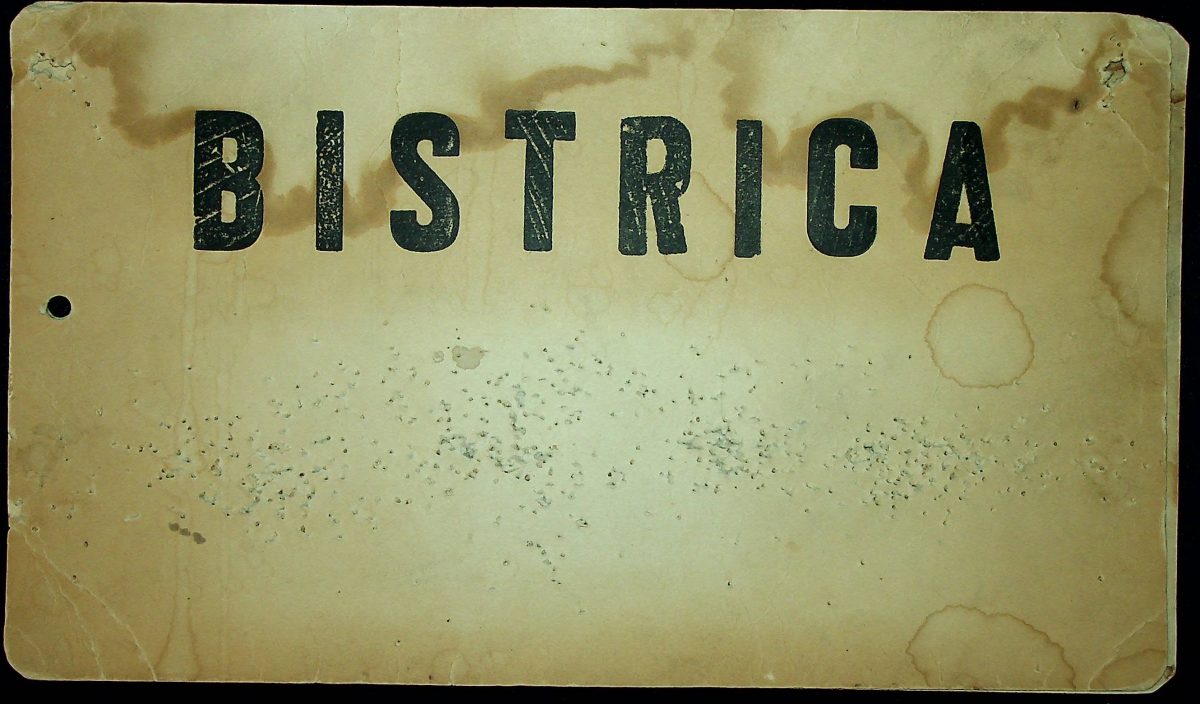After the Second World War, Prizren had only 20.000 inhabitants. The motivation that the victory against fascism brought and the socialist ideology’s struggle for the consciousness of the masses, pushed forward the development of the cinema, which was seen as a “dangerously” didactic device. During the war, the film screenings that were started in Prizren around 1926[1], came to a halt. The Yugoslav regime, which wanted to spread cinema as a device for mass “consciousness” all around the country, expropriated the house of the family Petkoviç, situated in the middle of Prizren. The house had 2 floors, 3 rooms above, 3 shops on the ground floor, in total 219 m2. On May 24th, 1950, including the 253 m2 of its garden, the house was expropriated and destroyed. As a replacement, on February 1st, 1952, the Bistrica cinema building with a capacity of 700 seats, opened its door to the public.
From that day on, this traditional and conservative city possessed a cinema built by the state. The door of the cinema was looking towards the riverside, provoking the modernisation of the city. Directed towards the Stone Bridge and Shadërvan, it became an imaginary and cognitive door as much as a physical one. On one hand, the traditional motifs were being reproduced “outside the door”; and on the other, the constantly moving, “unrestrainable” images “inside the door” were changing in 24 frames per second. Those two realities were in continuous conflict.
Through time, the population of the city increased. A garden cinema was opened next to the building and a road was built between the Bistrica cinema and the Bistrica river. Thus, the people that wanted to buy tickets and the cars that wanted to pass through the road became a headache for each other. Hereby, the two most important elements of modernity, “the cinema” and “the road”, came face to face: The cinema acted more generously in this special case.

Here is the first report that arrived to the administration of the Bistrica Building for closing the door looking south.
23.07.1965. Written by the director of the Prizren Internal Affair Secretariat. In the report titled “Measures to be Taken for the Safety of Cinema Audiences”, it is stated that the cinema door opening to Mose Pijade street should be closed, that the crowd formed at the entrance of the door both interrupted the traffic and endangered the safety of the people there, and that if no action is taken, the necessary actions to stop the activities of the cinema will be carried out by the Internal Affairs Secretariat.
22.09.1965. In the report sent by the Internal Affairs Secretariat, it was emphasized that the measures taken by the Bistrica cinema during the last 2 months were limited to changing the opening direction of the door (from outside to inside) and that these measures were not sufficient. In the text of the decision, it was underlined that if the requested regulations are not made within 1 month, the activities of the Bistrica cinema will be stopped.
While we witness the continuing rhetoric of the Ministries of Interior and their affiliated organizations in the documents dated to 1965, we see how the issue of “national interest”, which functions as a legitimation tool, is instrumentalized in the process of the door’s change.

22.10.1965. The management of the Bistrica cinema attempted to change the placement of the door and contacted neighbor Shemsije Kovaçi, to discuss the possibility of demolishing her house and moving the cinema entrance there. An apartment worth 6 million dinars was offered to the family in return for the expropriation of their homes. Shemsije Kovaçi, who rejected the proposal, then sent her husband, Xhevat Kovaçi, to the Prizren Municipality and Housing Affairs Directorate to express the family’s opinion on the matter. In his statement, Xhevat Kovaci emphasized that “they would not object if the expropriation of their house will be an action planned within the scope of “national interest”. But if their house will be the only estate to be expropriated, he continued, they would be against this decision and would expect the management of the cinema to agree with them.
08.11.1965. The situation was summarized in the letter sent by the Prizren Municipality and Housing Affairs Directorate to the Bistrica cinema and it was stated that the expropriation of Shemsije Kovaçi’s house was not compatible with the national interest and that the issue was considered within the scope of Bistrica cinema’s financial interest.
22.11.1965. Bistrica Cinema’s Management summarized the attempts they had made so far for the change of the entrance door. They stated that they were unsuccessful in this regard, and invited all relevant authorities to take initiative and cooperate to find a solution to the issue. In the same article, it was also stated that the closure of the only cinema in Prizren would have very negative effects in terms of the cultural and artistic life. In addition, the successes and vividness provided by the Bistrica cinema was explained and added to the text.
13.12.1965 – The last article in 1965 on the subject of the change of Bistrica Cinema’s entrance door was written by Muhamed Shukriu, the Director of Municipality and Housing Affairs of Prizren. Shukriu presented two alternatives in his article, the first of which was the expropriation of the houses of the Kovaçi family. He emphasized that this could be only done in agreement with the landlords. As a second alternative, it was stated that some shops and houses, which were expropriated before, could be demolished in Ramiz Sadiku Street. In the latter’s case, it was stated that the expropriation costs would be covered by the municipal budget, and that only the entrance door and ticket office should be built by the Bistrica Cinema.


In the report written by the Bistrica cinema administration (dated 22.04.1966) for the Prizren Municipal Affairs Unit, it was stated that the south-facing door will be closed and the new door will be opened on the east side, in accordance with the decision of the Interior Secretariat. The permit had been applied for the assembly and the construction of the ticket office.
The last article on this subject in the Lumbardhi archive is this report of the permission request. It is seen that the two alternative proposals suggested by Shukriu were implemented and the entry directions of the cinema building were changed to the east. The door entrance used by Lumbardhi Cinema today is the door entrance opened in 1966.[2]
The meaning of the door which we come into contact with dozens or even hundreds of times in daily life, is actually much more abstract and political than we are used to think. While the door provides privacy and security to the people, it also offers freedom. Because you can experience other “worlds” through the gates.
[1] Within the scope of the research we have done so far in the archive of the Lumbardhi Cinema, the earliest date of film screenings in Prizren is 1924. This data will be corrected if new information is found during the ongoing research.
[2] The door that is used today was changed recently (in 2020). We do not have more detailed information on whether another door was installed before the door was changed in 2020 (after 1966).
